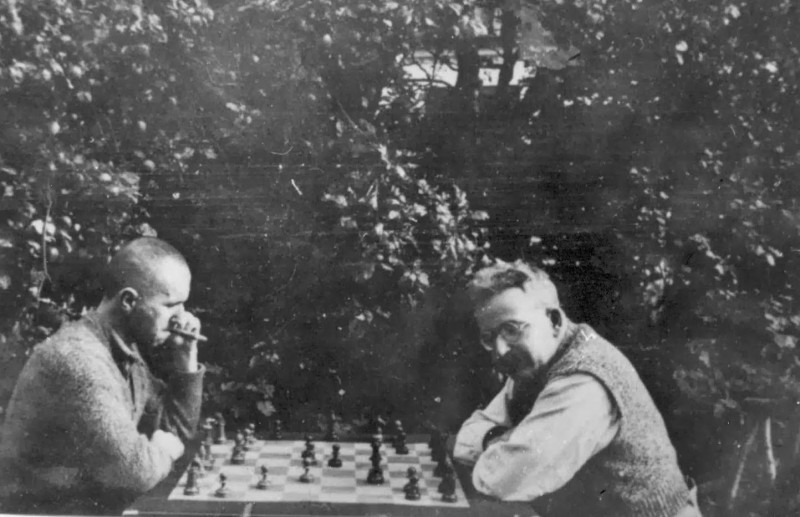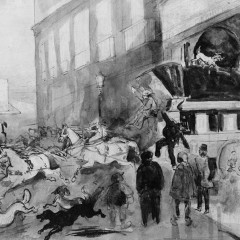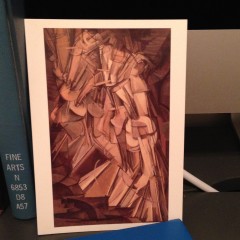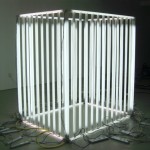In the last essay on the idea of “art’s immanence,” I tried to provide some basic remarks on Charles Baudelaire’s 1863 text, “The Painter of Modern Life”. I paid particular attention to the sense in which the “artist of modernity,” according to my interpretation of Baudelaire, is an artist that consciously reflects on, and exploits, their interiority to the peculiar social subject of the “crowd”.
In this essay, I want to further develop the idea of art’s immanence by focusing on a well-known text by the German philosopher and critic Walter Benjamin: “The Author as Producer” (1934). With the help of Benjamin’s text, we will begin to have a clearer idea of the way in which artists can function under the conditions of capitalism, that is, of what it means to be an artist “in” capitalism.
Baudelaire’s exposition of the painter of modern life emerges in a context in which capitalism is still in its infancy. Benjamin’s idea of the “author as producer” has, as its grounding premise, the analysis of the fundamental process of the production and circulation of capital as a comprehensive system of social, political, and economic relations in a more advanced stage of historical development.
He is also composing his thoughts with the tumultuous political revolutions of the early 20th century (the Bolshevik revolution of 1917) in mind and the geopolitical opposition created therein: the opposition of, on the one hand, Soviet Russia, and on the other hand, an emergent Western “bourgeois” nationalism (on a purely political level, the opposition that concerns Benjamin is that of communism and fascism).
The false opposition of art and politics
“The Author as Producer” begins with an important shift in conceptual emphasis about a perennially posed artistic-political problematic: how to create political art that is in direct opposition to the dominant way in which information and ideas are produced under capitalism. That is to say, against the ways in which capitalism produces ideas about our relations with each other and our environment.
The shift in conceptual emphasis Benjamin makes concerns our understanding of the standard opposition between art and politics. Instead of repeating the same logic of opposition, Benjamin wants to inquire into an artwork’s position within the cultural production of its time. Once again, at stake is a certain identification of the status of the art’s immanence.
The opposition between art and politics is crucial to our understanding of the development of modern and contemporary art. It is crucial in so far as it brings into sharp relief the question of the significance and necessity of art. The opposition of art and politics is normally understood in the following manner: there is, on the one hand, a purely formal art, one that foregoes any political responsibility of criticizing or resisting the mechanisms that limit the ideas about humans and their actions to preconceived notions. This kind of “pure” or merely “formal” art is preoccupied with what an artwork looks like, that is, its aesthetic dimensions.
There is, on the other hand, a purely “political” art. This is an art that tries to evade the ineluctable formal aspects of a work (what a work looks like), opting instead to be committed to its political articulation. Put another way: a political art focuses on the political content—information, message, and meaning—of art without worrying too much about its aesthetic dimensions.
The opposition between the first kind of art and the second is one that is, at bottom, based on the opposition between form and content. This opposition is putatively presented as a kind of static choice of “either/or”: either form and no politics—thus the endless reproduction of an art that presents itself as if it were free of its subjugation to the social relations of capitalism—or politics and no form—thus an art that is instrumentally reduced to the ideological outlook of a political program in such a way that art loses its specificity as an activity and simply becomes political activity.
(The opposition of form and content is related to the opposition between “autonomy” and “heteronomy”. Unfortunately, we do not have the space to go into this here. It is important, however, to keep the “autonomy-heteronomy” distinction in mind.)
Benjamin complicates this “either/or” logic by noting that the way in which the “art-politics” problem is grounded on the assumption that the two poles of the problem—art and capitalism—are externally related and mutually exclusive. More precisely, this assumption presupposes that (1) purely political art is formed outside capitalism and the social struggles that develop inside it—struggles such as workers’ movements (only by being external can it properly oppose); and (2) a purely formal art can just be made as if there is no social reality—with all its problems and contradictions – in which art is constitutively formed.
Benjamin sharpens the shift in theoretical focus by way of the status of technique. Technique, or the technical character of an artwork, already contains within itself the way in which “form” and “content” are interrelated. A technique is both the way in which a work is composed formally and the way in which a work is actually made at the level of its material production. It is the second aspect that is of some interest for us since it underscores the historical specificity of the production processes of culture.
Art in the digital age
To sharpen our sense of the historical specificity of cultural production, Benjamin reminds us that artistic genres are not timeless, but rather reflections of the social reality in which they exist. For example, a “novel” is not an artistic form that always existed, but emerged at a particular point in time and in a particular social situation. From the historical specificity of art’s production, Benjamin wants to draw attention to the process of an enlarged press and publishing industry (at the time of his writing in the 1930s) with the potential to liquidate the distinctions between particular genres of art.
At first blush, certain production processes appear to throw us into an inchoate matrix of non-disciplinary zones, that is, zones in which the clear distinction between cultural forms are radically dissolved. Let’s consider an example. The Internet network is a “space” in which everything appears to be connected in an effortless way: the shift from one hyperlink to the next is never properly reflected on. So much so, in fact, that we no longer have a clear sense what determines the transition from one link to the next. Rather, all that we are aware of is that there is a “wealth” of “information” that we can access with the mere click of a button.
Perhaps in a similar way to Baudelaire’s crowd, the Internet is that arena that gives the (false) impression of a kind of unmediated equality. What I mean by this is quite simply that it gives the impression that we are all equal in the network by virtue of our capacity to access it and, more importantly, upload our thoughts, images, videos, etc. It is on the basis of this impression of equality that we all become content generators (and with the help of technical advancements such as Web 2.0).
Digital production in the age of the Internet generates the conditions for a different kind of creative activity. One condition is worth noting. Under the conditions of digital production, there is no longer a clear separation between, on the one hand, the “artist” as a unique individual of creation, and on the other hand, the “viewer” as an indeterminate, passive person. Rather, the “viewer” in the digital age no longer simply “views,” but s/he always writes, re-posts, comments, or “likes” (as in Facebook), that is, always produces and reproduces what has been produced. To borrow an expression from Benjamin’s essay, we are “elevated instantaneously to the rank of correspondents”. As digital correspondents, we communicate the daily goings-on of life.
According to Benjamin, this transformation of “authors” into “producers” by the very means of technological production entails a crucial moment: it destroys the hierarchical opposition between those who are considered “fit” to correspond (individuals legitimated by authorities that manage who communicates and who does not) and those who are not (thus excluded from being part of the process of correspondence). Benjamin states quite unequivocally that, “the distinction between author and public, which the bourgeois press maintains by artificial means, is beginning to disappear.”
The organized collective subject
The disappearance of the hierarchical divisions of society is, however, geopolitically specific to Soviet Russia in Benjamin’s text. That is to say, it is specific to a context in which Communism has already gained power. What about the context of Western Europe and North America? What about the geopolitical realm in which the processes of literary production are not already “in the writer’s hands”?
In our context, the difficulty of the situation concerns the means of the production and reproduction of the Internet. Moreover, a political art practice—one that tries to participate in the transformation of social life from out of its current situation—is, if we are to follow Benjamin’s text carefully, based on the existence of an organized collective social subject that, as I noted in the last essay on Artblog, is oriented by the task to bring about social and historical change (this organized collective subject is, of course, the Bolshevik party in Soviet Russia).
The great difficulty for us is the impossibility of recognizing such an organized subject. This brings us to the second sense of immanence that Benjamin wants to render more concrete: the immanence of the artist to a specific political-social movement. According to Benjamin, a position that aligns itself to the politics of a social movement (of workers’ movements) is a position that is mired within the role of “ideological patron.”
Thus, for Benjamin, the social function of the intellectual/artist is to operate within the means of production understood as nothing less than a site of political, class struggle. Conscious reflection on the place of the artist within the production processes, and thus conscious reflection on the very mechanisms of the production processes, articulates commitment to the political struggles that emerge in capitalism. It is here that the artist can refunction the processes of production. (It is worth noting that Benjamin is explicitly drawing attention to Bertolt Brecht’s notion of “re-functioning” [Umfunktionierung].)
This is all well and good for an historical period in which something like a collective social subject—the proletariat—existed. For us today, a clearly definable organized subject does not exist. Thus, to refunction the means of production in and as class struggle no longer properly functions today in that the borders of “class struggle” are not so clearly defined relative to the processes of production. And it does not seem like the organization of such collective subject that will bring about change is very likely as, if we consider the effects of the Internet, the spatio-temporal realities of connectivity and communication have complicated matters considerably.
The complexity of the situation, and the contradictions that structure it (for example, the emergence of radical new potentiality of connectivity in an age in which the means of that connectivity renders us more alienated), is, I want to suggest, a useful phenomenon in the process of trying to give some specificity to the immanence of art.
One needs to be suspicious of phrases such as “everything is inside capitalism, therefore we are all doomed.” We need to be equally suspicious, however, of outbursts that proclaim that “there is an outside; we will always position ourselves against capitalism!” Crucially, our suspicion should not be of the psychological character that runs through each position (pessimism and optimism, respectively). Rather, we should be suspicious of the false dichotomy that grounds these two positions as if they were a fixed antinomy. Importantly, we should come to a deeper understanding of how this dichotomy is itself produced by the current means of creative production.
An artist focused on the problem of the conjunction of art and politics with a critical orientation—in some sense, we are all forced to consider this conjunction—needs to grasp what the specific status of their immanence to a particular historical juncture. I hope that the two “models” noted above—Baudelaire and Benjamin—shed some light on the issue.










